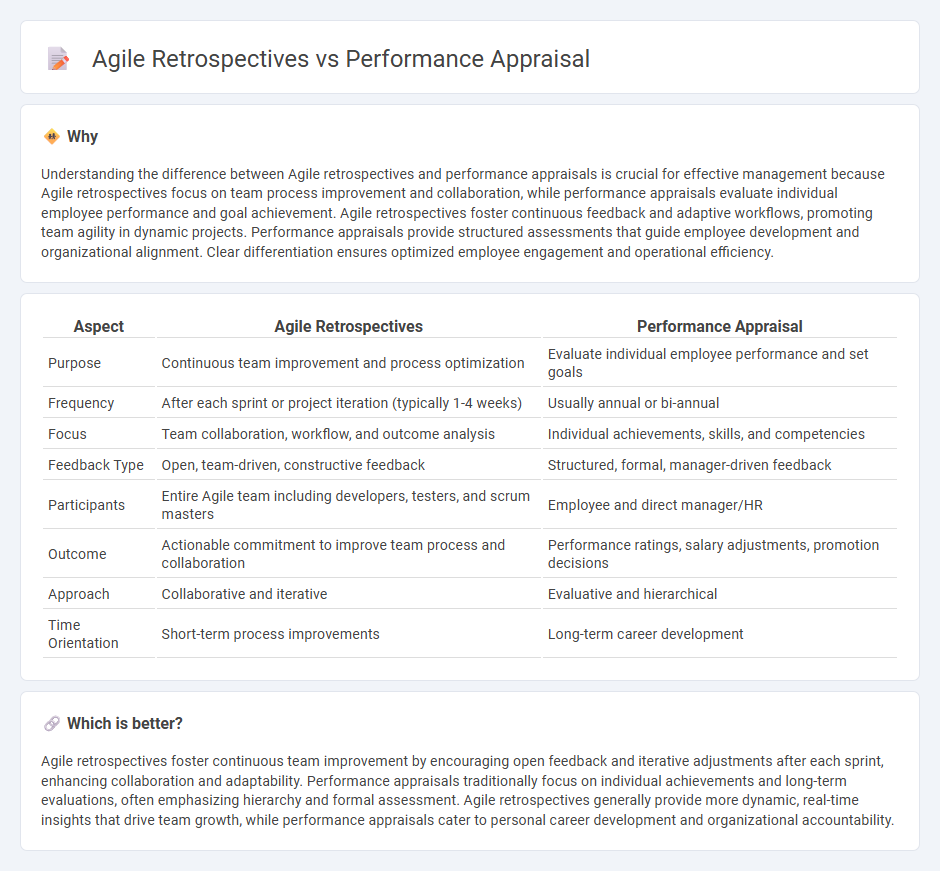
Agile retrospectives focus on continuous team improvement by reflecting on recent work cycles to identify successes and areas for growth, fostering collaboration and adaptability. Performance appraisals evaluate individual employee achievements against predefined goals, emphasizing accountability and formal feedback on personal development. Explore how integrating these approaches can enhance both team dynamics and individual performance.
Why it is important
Understanding the difference between Agile retrospectives and performance appraisals is crucial for effective management because Agile retrospectives focus on team process improvement and collaboration, while performance appraisals evaluate individual employee performance and goal achievement. Agile retrospectives foster continuous feedback and adaptive workflows, promoting team agility in dynamic projects. Performance appraisals provide structured assessments that guide employee development and organizational alignment. Clear differentiation ensures optimized employee engagement and operational efficiency.
Comparison Table
| Aspect | Agile Retrospectives | Performance Appraisal |
|---|---|---|
| Purpose | Continuous team improvement and process optimization | Evaluate individual employee performance and set goals |
| Frequency | After each sprint or project iteration (typically 1-4 weeks) | Usually annual or bi-annual |
| Focus | Team collaboration, workflow, and outcome analysis | Individual achievements, skills, and competencies |
| Feedback Type | Open, team-driven, constructive feedback | Structured, formal, manager-driven feedback |
| Participants | Entire Agile team including developers, testers, and scrum masters | Employee and direct manager/HR |
| Outcome | Actionable commitment to improve team process and collaboration | Performance ratings, salary adjustments, promotion decisions |
| Approach | Collaborative and iterative | Evaluative and hierarchical |
| Time Orientation | Short-term process improvements | Long-term career development |
Which is better?
Agile retrospectives foster continuous team improvement by encouraging open feedback and iterative adjustments after each sprint, enhancing collaboration and adaptability. Performance appraisals traditionally focus on individual achievements and long-term evaluations, often emphasizing hierarchy and formal assessment. Agile retrospectives generally provide more dynamic, real-time insights that drive team growth, while performance appraisals cater to personal career development and organizational accountability.
Connection
Agile retrospectives and performance appraisals are connected through their focus on continuous improvement and feedback within management practices. Agile retrospectives promote team reflection and adaptation after project iterations, fostering collaboration and identifying areas for growth. Performance appraisals systematically evaluate individual contributions and development goals, aligning personal performance with organizational objectives to drive productivity and career progression.
Key Terms
Evaluation
Performance appraisals provide a formal evaluation of employee achievements against predefined goals, often tied to compensation and career progression. Agile retrospectives emphasize continuous improvement by collaboratively assessing team processes and outcomes after each sprint to enhance future performance. Explore how these distinct evaluation methods can complement each other in optimizing workforce effectiveness.
Feedback
Performance appraisals typically deliver formal, periodic feedback centered on individual goals and organizational standards, providing structured evaluations of employee achievements. Agile retrospectives emphasize continuous, team-based feedback that promotes iterative improvements, transparency, and adaptive learning within small, frequent cycles. Explore how these distinct feedback mechanisms can enhance both personal growth and team dynamics in your workplace.
Continuous improvement
Performance appraisals traditionally evaluate employee achievements against set objectives, often conducted quarterly or annually to inform promotions and compensation. Agile retrospectives emphasize iterative learning and team collaboration, fostering continuous improvement by regularly reflecting on processes and outcomes after each sprint. Explore how integrating agile retrospectives can enhance performance management and drive ongoing organizational growth.
Source and External Links
Performance appraisal | EBSCO Research Starters - Performance appraisal is a systematic process used by organizations to evaluate employee performance and productivity in relation to predefined standards, providing feedback, identifying areas for improvement, and informing decisions on promotions and training.
Performance appraisal - Wikipedia - Performance appraisals are periodic reviews of employee job performance and productivity, using methods such as judgmental evaluations and objective measures to inform compensation, career development, and organizational decision-making.
What is Performance Appraisal? Key Concepts Explained - Performance appraisals are structured, regular reviews that assess how well an employee's work aligns with job expectations, helping organizations identify strengths, weaknesses, and opportunities for development and internal mobility.
 dowidth.com
dowidth.com